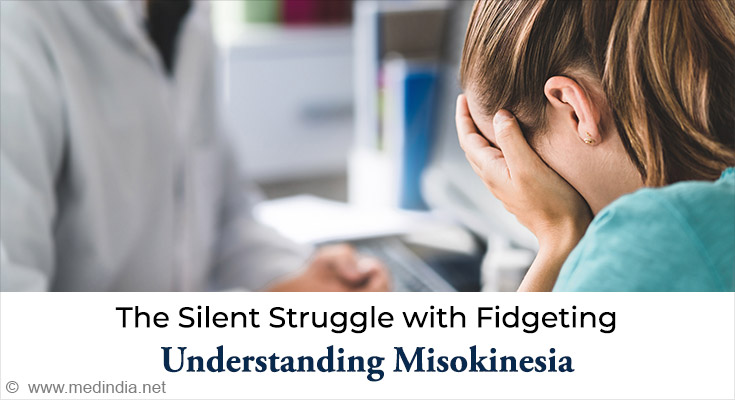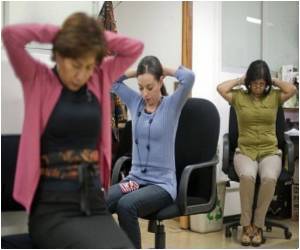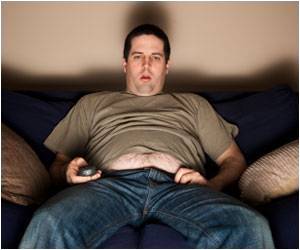- Misokinesia is a sensitivity to seeing others fidget that is prevalent in the general population - (https://pubmed.ncbi.nlm.nih.gov/34446737/)
- Imitation, empathy, and mirror neurons - (https://pubmed.ncbi.nlm.nih.gov/18793090/)
About
Have you ever found yourself distracted or agitated by someone fidgeting nearby- perhaps tapping their foot, clicking a pen, or constantly adjusting their sleeves? If so, you are not alone, and you may be experiencing a little-known but surprisingly common phenomenon known as misokinesia.
Did You Know?
The term misokinesia is so new that many psychologists only began researching it in depth after 2021! Turns out, fidgeting might be more triggering than we thought.
#misokinesia #mentalhealthawareness #visualtriggers #mindmatters #medindia
What is Misokinesia?
Misokinesia is a psychological condition where individuals experience strong negative emotions such as irritation, anxiety, or anger in response to seeing repetitive, small movements made by others(1✔ ✔Trusted Source
Misokinesia is a sensitivity to seeing others fidget that is prevalent in the general population
Go to source). These movements are typically harmless- like bouncing a leg, drumming fingers, or twirling a strand of hair- but for someone with misokinesia, they can feel overwhelmingly distracting or even intolerable.
The term comes from Greek roots: “miso” meaning hatred and “kinesis” meaning movement- essentially translating to “hatred of movement.” While it may sound like a niche annoyance, research suggests that 1 in 3 people may experience some level of this sensitivity(1✔ ✔Trusted Source
Misokinesia is a sensitivity to seeing others fidget that is prevalent in the general population
Go to source).
The Science Behind the Frustration
A groundbreaking study conducted at the University of British Columbia revealed that misokinesia may be more common than previously believed. Participants were exposed to videos of people performing minor repetitive actions. A significant number of viewers reported increased stress levels, anxiety, or discomfort, confirming that visual triggers can have a tangible emotional impact.
Interestingly, the condition is often misunderstood or confused with misophonia, which is the intense dislike of certain sounds, such as chewing or breathing. However, misokinesia is specifically tied to visual stimuli- it's not the noise of the fidgeting, but the sight of it, that sparks the distress.

Why Do Certain Movements Bother Us?
The exact cause of misokinesia is still under investigation, but scientists believe that it may be connected to mirror neuron activity in the brain. Mirror neurons are responsible for empathy and imitation- they fire when we observe others' actions and help us relate emotionally(2✔ ✔Trusted Source
Imitation, empathy, and mirror neurons
Go to source).
In individuals with misokinesia, these neurons may be overactive, leading them to unconsciously "mirror" the fidgeting or feel overwhelmed by the perceived restlessness of others. This can cause an internal sense of tension, making them feel uncomfortable or agitated, even if they consciously know the movement is harmless.
Everyday Impact of Misokinesia
Misokinesia can affect daily life in subtle but meaningful ways. Individuals may avoid shared workspaces, public transport, movie theaters, or even family gatherings, simply to escape triggers. It can strain relationships if the person closest to you has a habit of tapping their foot or twirling their pen- and doesn't understand why it affects you so deeply.
Moreover, because misokinesia is not widely recognized, those who suffer from it may feel isolated or misunderstood, thinking they are being overly sensitive or irrational.
Coping Strategies and Solutions for Misokinesia
While there's no definitive treatment for misokinesia, there are several strategies that can help manage its impact:
- Awareness & Communication: Understanding that your reactions are valid is the first step. Talking openly with friends or coworkers can help reduce tension and create empathy.
- Environmental Control: When possible, choose seating arrangements that reduce visual exposure to repetitive movements- such as sitting away from view or near calm individuals.
- Mindfulness & Relaxation Techniques: Practices like deep breathing, meditation, and progressive muscle relaxation can reduce overall irritability and help regain focus.
- Professional Support: Cognitive-behavioral therapy (CBT) has shown promise in helping individuals reframe and reduce the intensity of their responses.
It's also worth noting that many people experience misokinesia to varying degrees. You may not need treatment unless it begins to significantly impact your quality of life or relationships.









